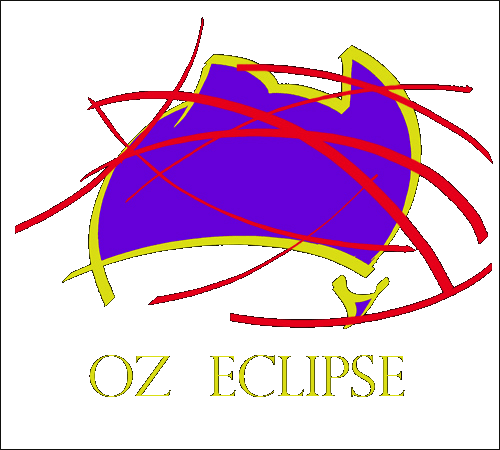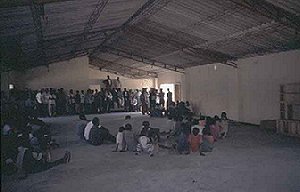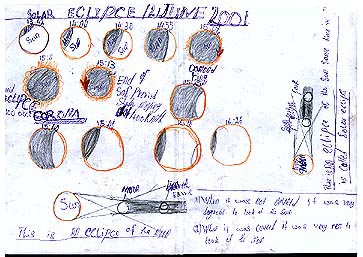
 |
WAITING FOR THE
SHADOW
SOLAR AND LUNAR ECLIPSE OBSERVINGREPORTS AND OBSERVATIONS - ZAMBIA 2001 |
|
|
|
|
|
|
|
|
|
Eclipse day
On the 19th and 20th, Bengt,
Christian, Jeffrey and I met up at the Zambia Air Services Training
Institute near the airport. We all stayed in the ZASTI college
accommodation for a few days either side of the eclipse.
We returned to the village on the day of the eclipse. The car was booked to arrive at 730am. Our driver was called Obet. The car was half an hour late. We packed equipment, food and drinks into the car. We were not even halfway to Lusaka when the exhaust came loose and began hammering the road. Obet turned off and went to a repair shop. He said, "Just five minutes boss and I'll get this welded back on." One African minute is equal to 6.52 minutes of solar time. More than half an hour later we were back on the road. My early start was not looking so early any more.
We arrived at Kapini at about 9.00am. The deputy head teacher Mrs J.B. Hateya and the senior teacher Mrs C.S. Sobingi greeted us as we arrived. We began to set up. After a short time, the school principal, Mr Bernard Chiwala arrived. All seemed pleased to see us.
 Above
left Joe Cali lines up the scope. Above
left Joe Cali lines up the scope. |
 Above
right School teachers and Institute staff Above
right School teachers and Institute staff |
The eclipse was due to begin at 1:30pm. We set up our cameras
and other equipment and then began talking to the villagers who
had begun to gather around the school to watch us. One student
turned up with sunglasses lined with silver sweet wrappers. I
assured him in no uncertain terms that he would go blind. The
grapevine is very effective and word spread like wildfire. We
didn't see any more sweet wrappers or smoked glass all day
A group of 8 Polish observers drove in and set up on the soccer pitch. I asked the teachers if they had permission from the school or village headmen to do this. They had not. We had intended to get all the villagers to spill onto the pitch just before totality. Since this group of observers and its South African tour organiser hadn't had the manners to seek permission to use the area, I had no hesitation in continuing with our plans to use the oval during totality. I also didn't see any reason to tell them of our plans. There's a bit of Mr Bean in all of us!
At midday my equipment still was not ready to go. There were many distractions and I was having a problem with the instrument balance. People were crowding me, trying to look through the telescope and asking lots of questions. It was my own fault because earlier I had allowed a couple of people to look through the instrument. This made everybody curious.
We'd promised to start giving talks at midday. I gave a quick introductory talk about the eclipse and then to my eternal gratitude Bengt, Jeffrey and Christian took over the talks leaving me more time to work on the balance and set up of my equipment.
 |
 |
Murphy Strikes Again
 The night before the
eclipse I'd decided to allow the school students conduct light
and temperature experiments. I thought that this would be a good
educational exercise and I was willing to accept poor quality
data if something went wrong. I expected something to go wrong,
these students were watching their first totality after all. Bernard
Chiwala located two bright young students, Friday Tembo and Florence
Chipote to undertake the experiment. At 1130UT, the students began
working on this project . Three grass fires were lit simultaneously
within 100 metres of the institute. Locals set grass fires frequently
and for no apparent reason. It has been part of the African way
of life for 450 000 years.
The night before the
eclipse I'd decided to allow the school students conduct light
and temperature experiments. I thought that this would be a good
educational exercise and I was willing to accept poor quality
data if something went wrong. I expected something to go wrong,
these students were watching their first totality after all. Bernard
Chiwala located two bright young students, Friday Tembo and Florence
Chipote to undertake the experiment. At 1130UT, the students began
working on this project . Three grass fires were lit simultaneously
within 100 metres of the institute. Locals set grass fires frequently
and for no apparent reason. It has been part of the African way
of life for 450 000 years.
In my "other" life, I work in Paleo-climatic paleo-vegetation reconstrution research. If you are interested in reading a very technical study of fire frequency and magnitude in Sub-Saharan Africa try Bird M.I. and Cali, J.A., A million year history of fire in Sub-Saharan Africa, Nature 394, 767-769, 1998.
The light and temperature data experiments
didn't work out. The data was spoiled by onookers casting shadows
on the detectors.
Friends of the two students can be seen crowding around in the photo by Bengt Alfredson. Florence and Friday were so intent on reading the meters and tatking data correctly, they didn't realize their friends were casting shadows on the detectors as they crowded round to look on.
Between first and second contact, the youngest children were sent inside the hall of the institute to watch a projected image in the hall. This photo also by Bengt Alfredson shows the children inside the hall during the partial eclipse. Older children were put into groups sharing the eclipse shades.
The smoke billowed up towards the
part of the sky where we would want observe totality in 90 minutes
time. Fortunately, the fires burned themselves out and fresh breezes
took the smoke away from our totality window out to the south-west
part of the sky. The Gods were smiling on our good deeds that
day.
One more thing went wrong before totality. During my balancing act, the solar filter came off my 500 f4.5 lens. It was pointing just off the sun at this time and I managed to melt a small puddle in the plastic cell of my 2x teleconverter. As I detached the camera and lenses smoke also billowed from the camera body and the teleconverter. Fortunately the smoke in the camera was from the teleconverter cell and had travelled through the aperture mechanism. No harm done aside from a little blemish on the cell.
(scientific results) |
eclipse photographs |
|
|
